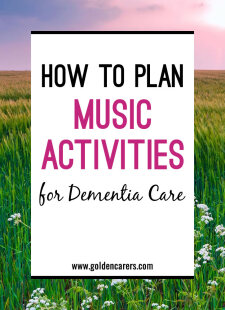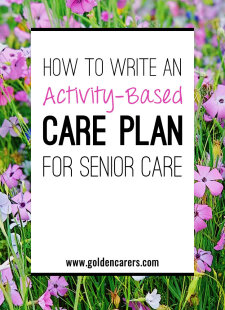10 Ways to Use Sensory Boxes & Multisensory Spaces

Everyone experiences the world through the senses: sight, smell, taste, touch, and hearing. These senses diminish with age, impacting lifestyle and well-being.
Sensory changes can cause problems communicating, enjoying activities, and staying connected with others. People living with dementia are especially impacted by sensory loss.
What are Sensory Activities?
Sensory activities can be used to strategically activate one or more of the senses to help people living with dementia connect with the world around them.
Sensory activities should be soothing and enjoyable. They may include things like gentle hand massages, bird-watching in the sunshine, and listening to music. Sensory activities can be non-verbal; thereby crossing cultural boundaries.
Related: Sensory Stimulation for Dementia Care
Benefits of Sensory Stimulation
- Improve behavior and mood
- Increase concentration & brain function
- Improve communication
- Encourage participation
- Boost self-esteem and well-being
Related: Catalog of Sensory Activity Ideas
Examples of Multi-Sensory Activities
Multisensory activities are activities that combine two or more senses. Most sensory stimulation activities involve two or more of the senses such as:
- Drawing and listening to classical music
- Hand massage and conversation
- Relaxing on a beanbag while watching colorful landscapes on a TV screen
- Having nails groomed in a garden setting
Related: Sensory Stimulation with Wind Chimes
What is a Sensory Box?
Rummage, Memory or Sensory boxes are containers filled with everyday objects to assist people living with dementia to interact, communicate, and reminisce. These activities can also be a soothing form of distraction.
Boxes can be created to cater to individual needs or for the general use of residents. The aim is to offer failure-free, gentle stimulation of sight, sound, taste, smell, touch, and movement in a controlled environment.
5 Sensory Box Ideas
The aim of sensory boxes is to offer the opportunity to stimulate as many senses as possible. This activity is also an opportunity to relax, contemplate, chat and reminisce.
Sometimes you will have to demonstrate (depending on age or stage of illness) the activity to engage the person; the emphasis is on enjoyment and participation. Thorough supervision is essential with these types of activities. Here are some ideas for sensory boxes:
Balls Box
A large plastic box or a small suitcase of balls in different textures; rubber, plastic, fabric, squishy, baby (with a bell inside), porcupine balls, massage balls, glow-in-the-dark balls. Any type of tactile ball is suitable. The quantity of balls depends on the size of the box you have.
Cereal Box
A large container (46 x 23 cm or 18 x 9 inches) half-filled with uncooked oats or rice bubbles (Any cereal on sale). Offer spoons, cups, and other utensils for exploration.
Kinetic Sand Play
Kinetic sand can be shaped and stretched without separating. Place sand on a large cooking tray and offer safety utensils for exploration. Consult with management before purchasing.
Seeds Box
Gather or buy large seeds such as pine cones, waratahs, acorns, jacaranda, or whatever seeds you have on hand e.g. avocado seeds, coconut, peach pits. Seeds can provide a variety of different textures, shapes, and sizes to explore. NOTE: Be mindful of safety risks; insert small seeds into zip-lock plastic bags to avoid choking.
Food
Place a few boiled eggs or peeled bananas on a plate along with plastic cutlery. Demonstrate cutting the food and encourage residents to cut and taste it.
5 Ways to Create Multisensory Spaces
The addition of multisensory spaces to your facility may inspire residents to explore, interact or have somewhere where they can ‘just be’. Here are a few ideas:
Office
Create a working office in a corner for people who insist they have to ‘go to work’. Provide an office desk, computer, files, pens and highlighters, a hole-punch, in-out trays etc
Indoor Forest
There are many things you can do to bring nature inside. Setup a nature corner that includes pot plants, the bark of twigs of trees, moss planted in pots, small tree branches and grasses, palm leaves, banana leaves, bird of paradise leaves, and ferns.
Rummage Dresser
Setup a three or four-drawer dresser in a corner and fill it with everyday items such as doilies, napkins, beanies, colored socks, scarves, baby clothes, tea towels, and other items. Some people may enjoy sorting and organizing them.
Outdoor Garden Shed
Setup a garden shed with an old plastic wheelbarrow, potting mixture, garden tools, and buckets. Ask residents to help you tend to raised garden beds nearby.
Old Car
Buy an old car that is still in reasonable condition (perhaps it could be donated if you spread the word around) and place it in the backyard of your facility, under a carport or driveway. Residents may feel compelled to ‘wash’ it, ‘fix’ it, or just sit in it.
This is just a start! There are many more stimulating areas worth trying: familiar foods, texture-rich materials, reading, massage, painting, outings, and music.
Connecting with the senses is a valuable way to communicate with people living with dementia.
Related: Snoezelen Rooms & Sensory Environments for Dementia Care
We'd love to hear your feedback. What has worked for you?






Yes i am also new to the sight and am so relieved to find so many ideas all on one sight and not have to spend hours on the internet looking for ideas, quizes and games, thank you all very much for offering so much. Its not only amazing it gets me excited to prepare secessions for my 1 on 1 dementia clients i have.
I work with a blind person one on one and i went through my kitchen for all kinds of containers or jars that have lids, some screw some you have to pull, all different kinds and then i found objects also round the house to put an object in the bottle or container. The lady had to work out how to open the container and then figure out what was inside, it worked very well, I put in all kind of different odd things i found in the house.
Hi Naomi
Very clever
What is a good activity for sundowners with stage 6 dementia. She constantly walks around and has a short attention span. We still have her at home and my husband is 24 hour care provider as well as a father of three little ones while i work All ideas are greatly appreciated.
Hi Stacey, caring for someone with late-stage dementia is very hard and I feel for you. Your husband could do with some help. Have you inquired if local authorities can assist you? Meanwhile, you can try giving her an album of family photos to peruse, laundry to fold, an old woolen pullover to unravel, vegetables to peel, dishes to wash. Keep safe.
I've tried having a bowl of different coloured pompoms and coloured clothes pegs. the idea is to attempt to pick up a pompom the same colour as the peg. It has to be on a tray with a lip or in a bowl because the pompoms get away. I've discovered that having just a single peg on the table (I'm doing this as one-to-one) works much better, less distraction. Usually lots of laughs as the pom pom skitters away. The exercise doesn't work as well in the evening and works best with primary colours.
Also, with 4 people and 4 balls rolling around the table top in different directions, absolute involvement and laughter. Of course I was chasing the ones that went on the floor. People did get tired fairly soon so I just quickly put them away, except for one which seemed to have disappeared until we found it hidden, tightly squeezed, in a resident's hand. :)
Hi Karen, what a great activity! It is Montessori-based and ideal for 1-2-1 or small groups. Good on you for having made the activity more practical.
I agree wholeheartedly that mental stimulation is essential to ward off dementia. I have MS and experience severe "brain fog". I am teaching myself Spanish and while my linguistic ability is not improving, my mental faculties is much sharper.
This is wonderful to hear Stephen! Thanks so much for your feedback and all the very best to you.
I am a new member and I'm enjoying reading about all these great ideas. I am especially drawn to the tactile and olfactory sensory activities as most of my clients suffer from various degrees of hearing, visual and fine motor impairments.
Thank you so much
Thanks so much for your feedback Yamilee!
I have used small plastic lunch boxes, filled one with uncooked rice, one with water, another with scented sheets the list can go on and on, this makes the activity easier and a great 1:1 session.
I use a 20 gallon tote and put shredded paper, the strips not the cross cut paper as this causes dust and may effect people with allergies. I use clothes pins, marbles, plastic spoons, a little plastic piggy bank, small candles(like tea lites), little river rocks, even colorful small feathers. We make a game of it and give points for the items. Highest score wins and I give lil surprise bags that have sugar free candies in them like Worthers Originals (sugar free). We enjoy this as an activity. Have fun use you imagination and create themes like holidays, birthdays, or seasons.
Sounds like you make a lot of effort Pamela. Can I come? :) Just a wee note, results recently that artificial sugars are definitely bad for folks with or at risk of Alzheimer's. I spoke with the nurses where I have clients and she said that unless there are serious diabetes problems and they are being monitored, that a single ordinary candy is okay. It's all a bit screwy anyway. The people with diabetes are supposed to watch their sugar intake but everyone gets those fruit juices full of fructose and little else.
At least while they are having fun with your activities they aren't drinking fake cranberry juice. :)
I've never personally given rewards for anything, but I've seen some of the other rec folks offer rewards for games (ie: Bingo), sometimes sweets but sometimes these are very small seasonal decorations. Dollar store packages of mini trees or bells or shamrocks, or .... Of course, it depends on whether or not your folks are likely to put it in their mouths... When I first started I took this lovely lady in late dementia the first daffodil from my garden. She looked at it, smiled at me and bit into it! Ah well, she wasn't poisoned. it's an ongoing process of discovery. So much fun!
Thanks for the feedback ladies, this is much appreciated.
I found all these ideas are really great fun and I am sure my residents @ nursing home they will enjoy them Also help to refresh my knoladge and skills please send me more ideas I really appreciate your kind support
Thank you for this, I have just set up my sensory boxes from this list and really looking forward to using them with our residents. I am so excited to start this session.